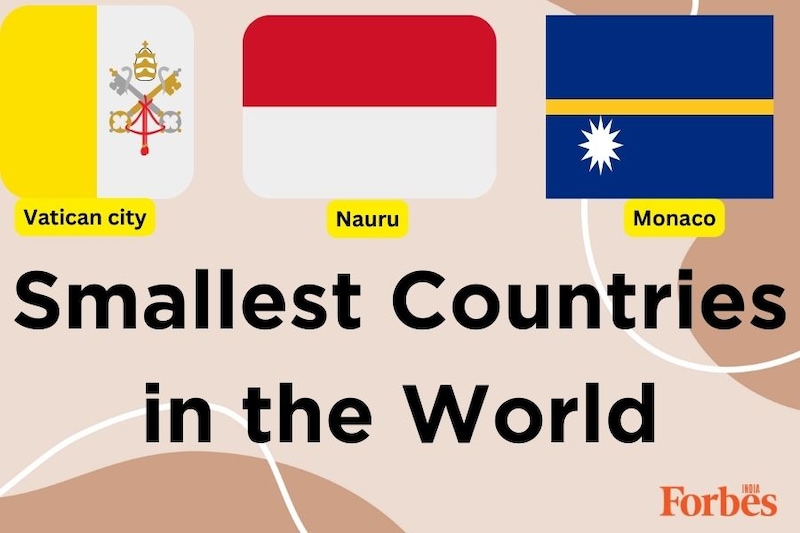
Ever wonder about the tiniest countries that dot our world map? They may be small in size, but they are important in their own right. From charming city-states to remote island nations, these pint-sized places have a lot to offer—like the Republic of Palau. Join us as we take a closer look at the top 10 smallest countries in the world.
Which are the smallest countries in the world?
Let’s look at the world’s smallest countries and their areas in the table below:
| Name of country | Area in sq km | Region |
|---|---|---|
| Vatican City | 0.44 | Southern Europe |
| Monaco | 1.95 | Southern Europe |
| Nauru | 21 | Oceania |
| Tuvalu | 26 | Oceania |
| San Marino | 61 | Southern Europe |
| Liechtenstein | 160 | Western Europe |
| Marshall Islands | 181 | Oceania |
| Saint Kitts and Nevis | 261 | Caribbean |
| Maldives | 298 | Western Asia |
| Malta | 316 | Southern Europe |
Now, a closer look at the smallest countries of the world. Note: We have sourced the 2024 GDPs of the smallest nations from the IMF
Vatican City
- Population: 497
- GDP: NA
- Currency: Euro
Vatican City is the smallest independent state in the world, both in terms of size and population. Despite being the world’s smallest country, the Vatican holds immense significance as the spiritual and administrative centre of the Catholic Church. Visitors flock to marvel at iconic landmarks like St. Peter’s Basilica and the Vatican Museums, home to priceless artistic treasures, including Michelangelo’s Sistine Chapel ceiling.
Monaco
- Population: 38,587
- GDP: NA
- Currency: Euro
Perched along the sun-kissed French Riviera, Monaco exudes glamour and luxury. Renowned for its opulent casinos, prestigious Grand Prix circuit, and breathtaking views of the Mediterranean, this principality captivates visitors with its blend of old-world charm.
Nauru
- Population: 11,947
- GDP: $0.16 billion
- Currency: Australian Dollar
Nauru is a remote island nation in the central Pacific Ocean known for its idyllic tropical landscapes and rich marine biodiversity. Once a bustling hub of phosphate mining, today it offers travellers the chance to immerse themselves in pristine natural beauty, from its coral reefs teeming with life to its secluded beaches bordered with palm trees.
Tuvalu
- Population: 9,646
- GDP: $0.07 billion
- Currency: Tuvaluan dollar
With its palm-fringed atolls and crystal-clear lagoons, Tuvalu epitomises the tranquil beauty of the South Pacific. As one of the world’s smallest and most remote countries, it boasts a laid-back island lifestyle and a strong sense of community. Visitors can experience the warmth of Tuvaluan hospitality while exploring its unspoiled beaches and vibrant coral reefs.Also Read: Top 10 most spoken languages in the world in 2024
San Marino
- Population: 33,581
- GDP: $2.03 billion
- Currency: Euro
Perched atop a scenic mountain in northern Italy, San Marino is the world’s oldest republic. Steeped in history and surrounded by panoramic views of the Italian countryside, this tiny enclave charms visitors with its mediaeval fortresses, quaint cobblestone streets, and rich cultural heritage.
Liechtenstein
- Population: 39,870
- GDP: NA
- Currency: Swiss Franc
Tucked between Switzerland and Austria, Liechtenstein is a picturesque principality renowned for its pristine Alpine landscapes and charming villages. Despite its small size, it offers many outdoor adventures, from hiking and skiing in the mountains to exploring mediaeval castles and sampling local delicacies.
Marshall Islands
- Population: 37,548
- GDP: $0.31 billion
- Currency: United States Dollar
Scattered across the Pacific Ocean, the Marshall Islands comprise a collection of coral atolls and islands teeming with natural beauty. Rich in culture and history, this remote archipelago offers tourists the chance to immerse themselves in traditional Marshallese customs, explore WWII relics, and dive among vibrant coral reefs.
Saint Kitts and Nevis
- Population: 46,843
- GDP: $1.13 billion
- Currency: East Caribbean Dollar
Nestled in the Caribbean Sea, Saint Kitts and Nevis are a duo of tropical islands renowned for their pristine beaches, lush rainforests, and rich colonial heritage. Visitors can stroll through charming colonial towns, hike to volcanic peaks, and indulge in water sports while soaking up the laid-back Caribbean vibe.
Maldives
- Population: 527,799
- GDP: $7.2 billion
- Currency: Maldivian Rufiyaa
The Maldives is a tropical paradise like no other, renowned for its picture-perfect beaches, turquoise lagoons, and luxurious overwater bungalows. Comprising over a thousand coral islands in the Indian Ocean, it offers visitors the chance to escape to secluded resorts, dive among vibrant coral reefs, and experience the magic of sunset cruises.
Malta
- Population: 539,607
- GDP: $22.74 billion
- Currency: Maltese lira
Steeped in history and bathed in Mediterranean sunshine, Malta is a captivating island nation brimming with ancient ruins, Baroque architecture, and azure waters. From exploring UNESCO World Heritage sites like the ancient city of Valletta to swimming in secluded coves and savouring delicious Maltese cuisine, there’s no shortage of adventures to be had in this compact yet captivating destination.
Frequently Asked Questions (FAQs)
1. Are there advantages to being a small country?Small countries often enjoy unique advantages such as greater flexibility in governance, more efficient decision-making processes, and closer-knit communities. Additionally, they may benefit from specialised industries, tourism appeal, and cultural distinctiveness.2. How do small countries fare on the global stage?While small countries may lack the geopolitical influence of larger nations, many actively participate in international affairs through diplomacy, trade agreements, and memberships in organisations like the United Nations. Some small countries also punch above their weight in areas such as innovation, finance, or tourism.3. What are some challenges faced by small countries?Small countries may encounter challenges such as limited resources, vulnerability to external pressures, and economic dependence on larger nations or industries. Additionally, their small size can pose logistical and infrastructural constraints.
